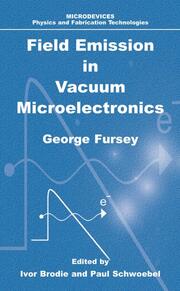-
Zusatztext
-
Inhaltsangabe- Foreword. Historical Overview. 1: Field emission from metals. 1.1. FowlerNordheim theory. 1.2. Thermalfield emission. 1.3. Elaboration theory of the field emission theory from metals. 1.4. Resume. 2: Characteristic features of field emission in very high electric fields and high current densities. 2.1. Deviations from the FowlerNordheim theory in very high electric fields. 2.2. Space charge influence on field emission. 2.3. Influence of space charge of relativity electrons on field emission. 2.4. About the potential barrier shape in strong electric fields. 2.5. Resume. 3: Maximum obtainable field emission current densities. 3.1. Theoretical limit of field emission current. 3.2. Effects preceding field emitter explosion. 3.3. Heating as the cause of field emission cathode instabilities. 3.5. Highest field emission current densities achieved experimentally. 3.6. Resume. 4: Field emission in a microwave field. 4.1. Introduction. 4.2. The condition of adiabaticity tunneling time. 4.3. Experimental verification of the validity of fn theory in a microwave field. 4.4. Maximum field emission current densities for a microwave field. 4.5. Elimination of the ion bombardment. 4.6. Transit time in a microwave field diode with field emission cathode. Energy spectra of electrons. 4.7. Field emission from a liquid surface in a microwave field. 4.8. Resume. 5: Field emission from semiconductors. 5.1. Introduction. 5.2. Cleaning the emitter surface and obtaining fieldemission patterns. 5.3. Experimental field emission currentvoltage characteristics. 5.4. On preserving the initial surface properties of a field emitter. 5.5. Voltage drop across the sample and the field distribution in the emitting tip area. 5.6. Theory of the field electron emission from semiconductors. 5.7. Transition processes in field emission from semiconductors. 5.8. Stable semiconductor field emission cathode. 5.9. Some experiments on adsorption. 5.10. Resume. 6: Statistical processes in field electron emission. 6.1. Formulation of the problem. 6.2. Method of investigation. 6.3. Statistics of field emission from metals. 6.4. Investigation of field emission statistics at cryogenic temperatures. 6.5. Multielectron field emission from high temperature superconductors ceramics. 6.6. Investigations of field emission statistics for highly transparent barriers. 6.7. Resume. 7: The use of point fieldemission cathodes in electronoptical systems: field emission localization to small solid angles. 7.1. Introduction. 7.2. The optimum crystallographic orientation of the field emission cathode. 7.3. Field emission localization by thermalfield surface self diffusion. 7.4. Field emission localization due to a local decrease of work function by selective adsorption. 7.5. Field emission from atomically sharp protuberances. 7.6. Some applications of fieldemission cathodes in electronoptical devices. 7.7. Resume. 8: Advance in Applications. 8.1.
-
Detailansicht
Field Emission in Vacuum Microelectronics
Microdevices
ISBN/EAN: 9780306474507
Umbreit-Nr.: 1717574
Sprache:
Englisch
Umfang: xv, 205 S.
Format in cm:
Einband:
gebundenes Buch
Erschienen am 21.01.2005
Auflage: 1/2005


